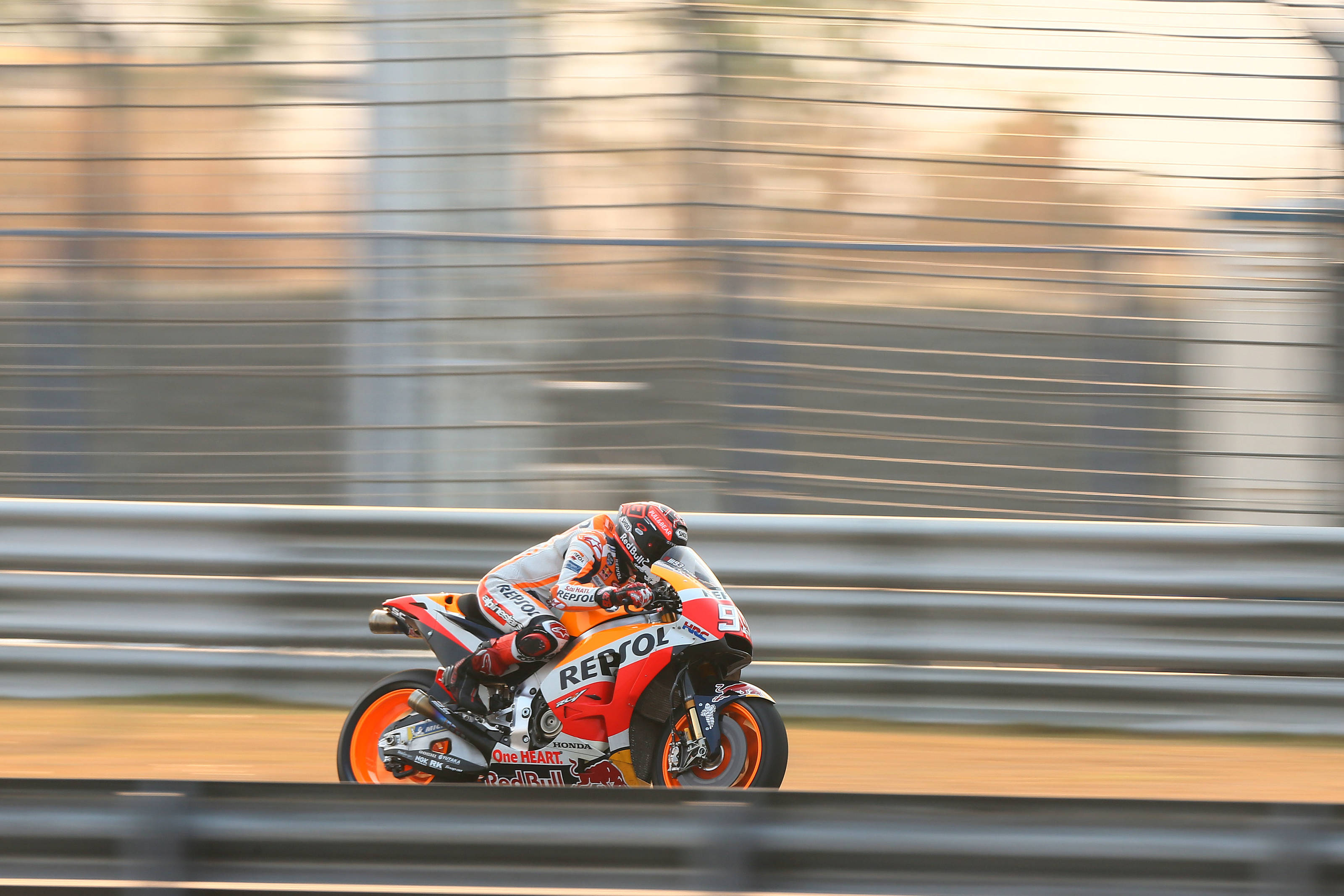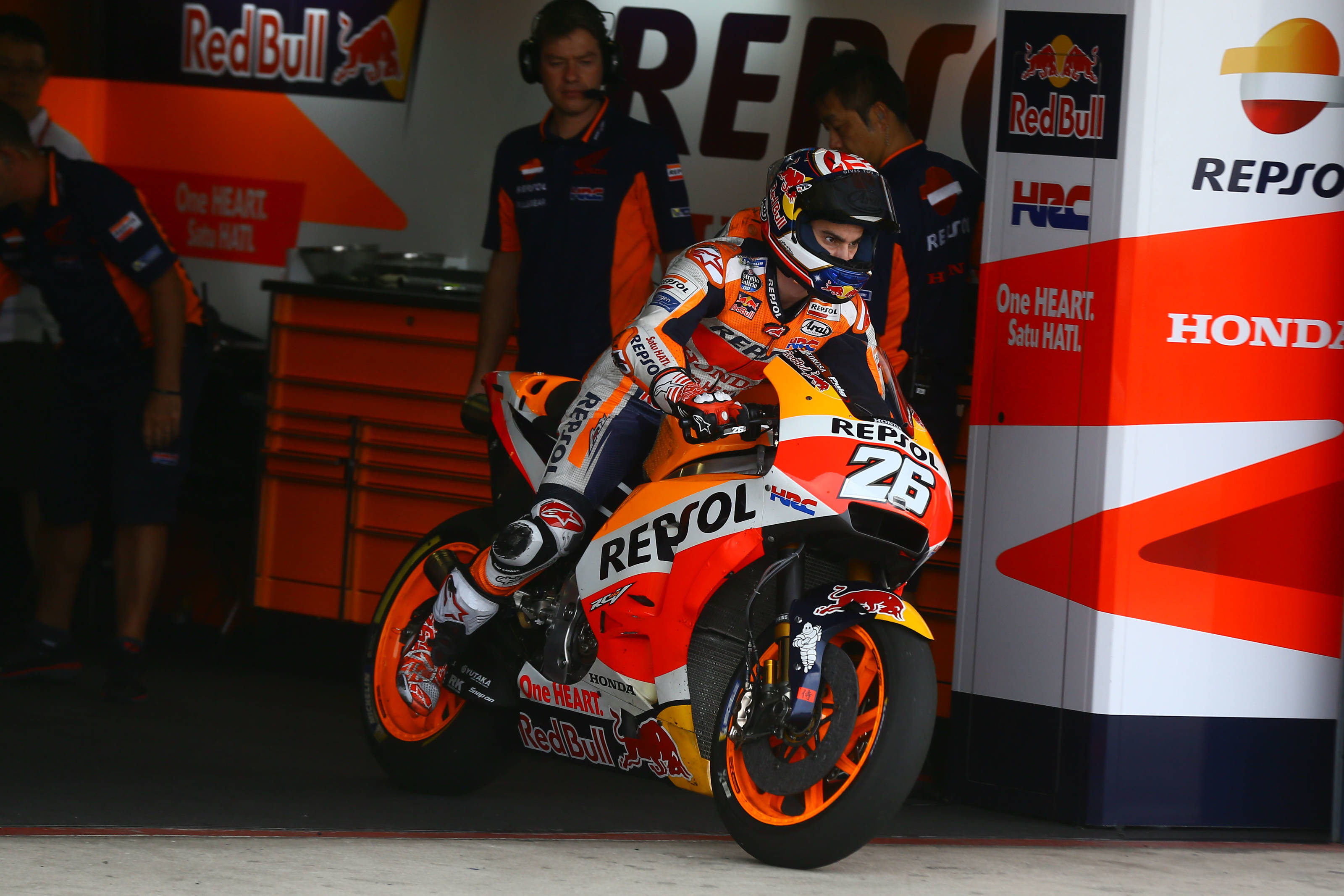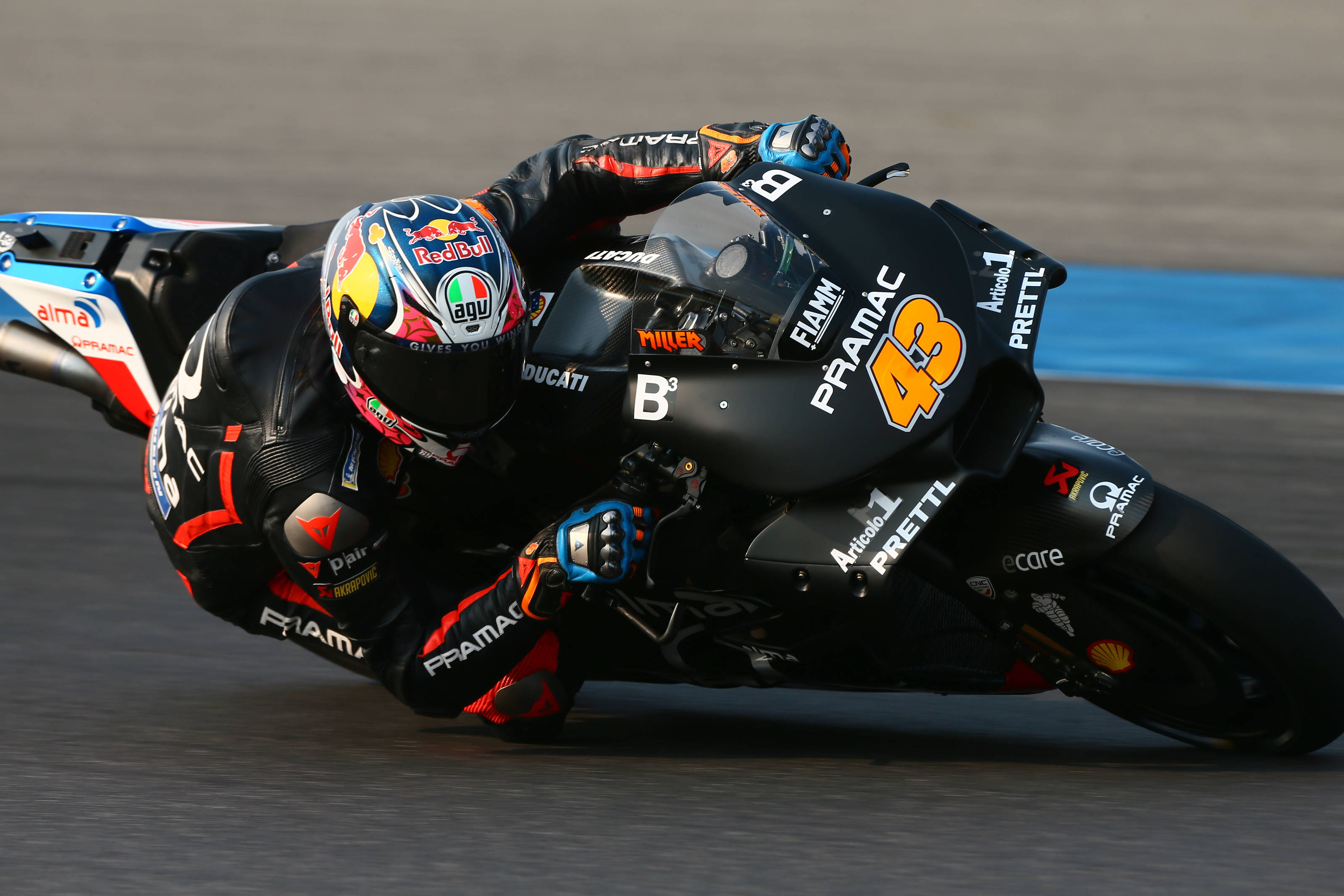
The MotoGP circus arrived in Thailand for the Championship’s first exploration of the Chang International Circuit – new for the 2018 season – and for the second official test of the 2018 preseason, following the Sepang test two weeks ago.
That Sepang test gave opportunities for the manufacturers to test some new items, and discover the strengths and weaknesses of their 2018 machines. Ducati’s official riders, Jorge Lorenzo and 2017 title challenger Andrea Dovizioso, got their first tastes of the GP18 which test rider Casey Stoner had described as having no negative points. That claim was backed up by the consistently impressive pace of both Lorenzo and Dovizioso over the three days in Malaysia, culminating in a new lap record for the Spaniard on the final day. Still, coming to Thailand, Ducati had some new things to try: notably a new chassis, updated from that used at Sepang, and two new aero fairings. For Andrea Dovizioso, there was a positive outcome after testing the new parts. He declared himself a happy man after day two in Buriram, stating that, although the new chassis and fairing did not offer the sort of ‘spark’ to cure completely Ducati’s traditional turning problems, the speed he was able to show with any combination of 2017 and 2018 parts was a positive sign. The positivity on the #04 side of the Ducati garage continued into Sunday, although Dovizioso managed only seventh in the combined times from the three days, as he claimed at the end of day three that the base setting he has is a good one, and that he is able to be fast in all the circuits.
In comparison, it was not such a successful test for the other side of the Ducati box, with Jorge Lorenzo struggling on the first day with gearing issues, and then a problem with the chassis in his first bike on Saturday. Come Saturday afternoon, the Spaniard had a new chassis, but now an ill-tempered engine, which was down on power. On the final day, Lorenzo switched back to the 2017 chassis in a hope to rediscover some confidence, and also to compare more the GP18 and GP17. In the end he admitted that the 2017 bike has some advantages over the 2018 machine, but that he would pick the new bike to race if he had to today as it has more potential. Still, Lorenzo finished the final day in Thailand down in 22nd place, owing to his lack of want to make a time attack lap on Sunday, as many of the rest of the grid did. It has to be said that the Qatar test in a few weeks will be a crucial one for Lorenzo, as he is still missing a lot from the 2018 bike, and if he is to challenge for the title this season, he will need to solve his issues as soon as possible, considering the searing pace of some of the other front runners.
In addition to that, Danilo Petrucci might just fancy himself to knock one of the nine’s off the front of the second Ducati next season. The Pramac rider announced before the Sepang test that 2018 will be his last season with the Ducati satellite team – Petrucci is looking for a factory ride and, at 27-years-old, the ex-Superstock rider is not exactly befitting of a Ducati ‘junior team’ ride, from the perspective of either him or Ducati. Although Lorenzo took the headline time in Malaysia on the final day, Petrucci has been at least within range the Spaniard on each of the other five days. It is true that Petrucci’s teammate, Jack Miller, has perhaps overshadowed the Italian so far with his impressively quick adaptation to the Ducati, but it is worth pointing out that the Australian is on year-old machinery, with twelve months of data prepared. But Petrucci, on the third brand-new GP18, and with the option of a factory contract should he meet certain expectations, is surely now putting pressure on Lorenzo for his seat, and the performance of Jorge in Thailand will do Danilo’s case no harm at all. And, in any case, Petrucci was less than two tenths behind Dovizioso in the combined times, and like his compatriot did not try for a fast lap. The seemingly brewing duel between Lorenzo and Petrucci for the second Ducati seat could be quite interesting in the first part of the season.
Over at Yamaha, things began well in the Sepang test, and the factory pairing of Maverick Vinales and Valentino Rossi even ended the second day in Malaysia 1-2. But in the four test days since that Yamaha lockout, the Tuning Fork has struggled with rear traction, notably on acceleration. Yamaha’s rear traction is becoming something like Ducati’s turning: forever plaguing them, and forever without a fix. In 2017, Yamaha tried a plethora of different chassis’ to try to make the rear tyre grip, but there was no consistent solution. This year, they arrived in Sepang with a new chassis, that both riders seemed to like, Rossi in particular. As a result, Yamaha are now focussing almost exclusively on the electronics to find some traction. It is without doubt, and in fact admitted by Yamaha, that Honda and Ducati have found something in the spec electronics since 2016 that Yamaha have not, and for Yamaha it is crucial to resolve this missing jigsaw piece if they are to challenge for the world title this season. Rossi has admitted that it is unlikely that Yamaha will solve the problems before the start of the season at the end of March, but what could pull them out of the hole they are currently inhabiting, at least in the short term, is the cooler temperatures in Qatar, thanks to the Grand Prix there being a night race.

One positive for Yamaha is that Rossi claimed to have found something at the end of the final day in Thailand, but made a mistake at the end of a good lap. He made a 1’30.5 as his best time, but reckons a 30.2 could have been possible without the mistake. Even still, this time would have put him five tenths behind the headline time of Dani Pedrosa. Additionally, as Vinales pointed out, one lap on a new tyre for the M1 is somewhat okay, but after that the pace becomes a lot worse. And, even though Rossi claimed to make a step on the final day, Vinales said the same thing after day two, but on Sunday continued to struggle, both for pace and direction. This, combined with the sudden drop off on Sepang day three, shows that Yamaha have also carried their other 2017 trait into the new year, that being inconsistency, which implies that the 2018 M1 is just as much on a knife edge as its predecessor. And, of course, all of this is made worse by the fact that Johann Zarco, on the Tech 3 bike (with the 2016 or 2017 chassis), has been competitive on all six test days so far. In fact, in Thailand the Frenchman was the only rider to stop Honda taking the 1-2-3 as he posted the second fastest time over the three days.
Zarco attributes his pace to his imitation of Jorge Lorenzo’s style when he rode the M1. It has been noted by many that Zarco’s throttle application is almost second-to-none in terms of smoothness, but perhaps his decision to return to the 2016 chassis after the Sepang tests has a deeper reason than just Zarco’s inexperience in MotoGP, and the amount he would have to learn to continue with the 2017 frame. Throughout 2017, Valentino Rossi claimed that the M1 no longer felt like an M1, that it had lost some of its traditional characteristics, notably its ability to carry corner speed. It was this characteristic which was critical for Yamaha, and propelled it to most of its success – the M1 has never had particularly good acceleration, but it was always able to get away with it thanks to its high corner speed. That was a characteristic which Zarco exploited superbly in 2017 with the 2016 chassis thanks to his ultra-smooth technique, and perhaps with the 2017 version in Sepang he felt unable to replicate that. Additionally, lower mid-corner speed means that harder acceleration is necessary, which stresses the rear tyre more. Honda and Ducati can get away with this because they understand the Magnetti Marelli ECU quite well, and a lot better, it seems, than Yamaha. This explains why Yamaha struggle over one lap, because they are cutting the power so much because the understanding of the electronics is not what it needs to be, and also why they struggle over a race distance, because the higher stress on the rear tyre caused by the lower corner speed leads to excessive wear, which further exaggerates the electronic deficiencies. In short, Yamaha have two options: they can try more chassis’ to make allow for more corner speed, or they can solve the problem electronically. Considering the praise heaped on the new frame by Valentino Rossi, whose feedback has been publicly announced as more valuable than Maverick Vinales’, it seems the second option is more likely. Contrarily, Vinales claimed the new chassis is too soft. The conflicting styles at Yamaha will not help development, meanwhile Zarco was the fastest Yamaha with the 2016 chassis, even though Vinales too tried it on the final day. Time is running out for Yamaha, quickly, and their problems only seem to be increasing. In addition to the on-track problems this could cause, it may even dissuade Rossi from renewing with the team for 2019. “The Doctor” has always maintained that he will continue in MotoGP as long as he is competitive and enjoying riding, but an unpredictable motorcycle yielding few podiums and many disappointments for a second consecutive year might persuade him to call time.
Very much on the contrary, Honda have probably had the most successful 2018 preseason so far, and probably their best since 2014. In Sepang they understood that the two engines they had were both positive, and just needed to understand whether the more aggressive, more powerful one would hinder them on tighter circuits, and in cooler temperatures. In Sepang they also had a new aero fairing, following a similar philosophy to Ducati, with the ‘hammerhead’ or ‘hamster cheek’ style. For Thailand, they had a revised fairing, which was essentially a toned-down version of the one they used in Sepang. Both riders reported little difference, but were positive about both versions. On the engine front, Marquez was still cautious after day one, in summary suggesting that whilst the engine seemed good, the heat could be tricking them, just as in Sepang. It must be said that it seems that Honda and Marquez have learned from their 2015/16 experiences, when they picked engines which were powerful and aggressive, because they worked at Sepang, which is hot; and Phillip Island, which is fast and wide-open. In essence, whilst Marquez looks by far the strongest rider at the moment, neither he nor Honda are getting ahead of themselves.
The final HRC piece came out on Sunday – a new, carbon swingarm. Dani Pedrosa, who set the fastest time on the final day to top the whole test, was content, if cautious. It was his first time trying a carbon swingarm, and noted that this meant it was difficult to understand if he was using it correctly. This means that it is something he is keen to try more in the future, and he seems to think there is potential in it. As for Marquez, he explained that there is more grip with the carbon swingarm, but that it is less stable with a used tyre. One of the traits of a carbon swingarm is that it moves more harshly, due to the increased rigidity compared to the more common aluminium, and this creates a more aggressive rear feeling. It is interesting to note that, when Speed UP ran a carbon swingarm in Moto2, they suffered the most in hot conditions. It will therefore be interesting to see the performance of the Hondas with this new part in Qatar where it should be cooler than Thailand.
The pace of the factory Hondas was backed up by the LCR machine of Cal Crutchlow, who ended the test 0.283 off the top time of Pedrosa, missing the 1’29s by just 0.064 seconds, and meaning that only Zarco prevented a Honda top 3 lockout. Honestly the signs coming from the 2018 Honda, particularly the one with the #93 on it, are worrying for the competition. It could be 2014 all over again.

One of the things Honda have improved over the winter, it seems, is the rideability of the RC213V. Jack Miller departed the Marc VDS team over the winter and claimed the Ducati he switched to turns better than the Honda he left behind – a remarkable statement. Equally, Tito Rabat jumped on the Avintia Ducati for 2018 and has all of a sudden turned into a MotoGP rider, such was the difficulty of the old Honda, even with the big bang engine of last year. The 2018 bike, though, seems like a different story, with rookies Franco Morbidelli and Takaaki Nakagami both ending the Thailand test within one second of Pedrosa’s top time. In fact, Nakagami ended the test in the top ten, and Morbidelli was just one place, and just over a tenth behind his mentor, Valentino Rossi. Even Tom Luthi, in just his second MotoGP test, was only 1.5 seconds off the top time, and less than half a tenth behind the factory Aprilia of Scott Redding.
Still, probably the standout rookie from this test was the temporary-for-now replacement for Jonas Folger, Hafizh Syahrin, who ended the test ahead of both Karel Abraham and Xavier Simeon, and only 1.756 seconds off the top time. And on top of that, he made improvements every day, despite a crash on day two. As job interviews go, it’s probably fair to say that this was a good one by the first Malaysian to ride a MotoGP bike.
Suzuki had a positive test. On the first day, Alex Rins set the second fastest time of the day, and Andrea Iannone experienced is best day aboard the GSX-RR. Come the end of day three, and Rins was fifth on the combined times, having confirmed positive feelings from the new, Ducati-style aero fairing on day two, and Andrea Iannone was suffering on one lap, but on race pace was quite positive, as was his outlook for the development direction. The Qatar test will be very interesting with respect to Suzuki, because it looks as though they might be back to the level of 2016, or at least somewhere close.
As for Aprilia, their testing plans are somewhat hindered by the lack of a new engine which is unlikely to arrive before the Qatar race. It was discussed a lot last year, especially by Aleix Espargaro, that the RSGP excels on corner entry, and also the mid-corner, but struggles for acceleration on the exit. The problem is different to Yamaha’s, at least for now, as the Noale manufacturer is simply lacking low-down power at the moment. But, of course, there is always the threat that the addition of power can lead to negatives for the handling. But, with that said, praise had been heaped by both Aleix and teammate Scott Redding on the new chassis Aprilia have been using since Sepang. The improvements from Noale were backed up in Thailand by the RSGP’s speed in the second half of the lap, which is very tight and twisty. Of course, the problem arrives in the first sector, which is essentially a pair of drag strips connected by a bland, second gear hairpin. Still, the Gresini-Aprilia camp remains positive, and with the new engine arriving hopefully in time for the Qatar race, 2018 could be an extremely positive season for them.
In Sepang, all three of the KTM riders complained that, whilst the latest edition of the RC16 is an improvement in the mid-corner compared to its predecessor, the 2018 bike has suffered on corner entry in comparison to last year. Although the team was missing Pol Espargaro for Thailand, due to injury, Bradley Smith was happy after the second day that the corner entry issues had been resolved with some setting changes. Also, in typical KTM style, there were many things for both Bradley Smith and Mika Kallio to test in Buriram, such as a couple of new aerodynamic solutions, some new electronic setups and chassis refinements, and improvements were found in all areas. With Espargaro hopefully able to return for the Qatar test, the development should increase even further. At the end of last season, KTM were making regular appearances in the top twelve and even a few in the top ten, and they look right on course to start challenging for the top eight this season.
All in all, the Thailand test was enlightening, and showed us some of the things which perhaps Sepang disguised. Many teams have a lot of work to do, and others some small refinements. There are three days of testing left in Qatar in the beginning of March for teams to do the final preparations for the beginning of the season, and there is no doubt they will all be crucial. After that, it’s race time.
Image copyright & Images, curtsey of Redbull contentpool

Leave a Reply